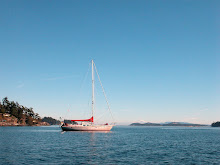Canvass And Wood Frame Kayaks
By our second morning at Sildefiorde, the rain and fog returned leaving no trace of the previous summer day. We contemplated staying another night to avoid moving in the pouring rain but decided the most productive way to spend a wet day was for us to go back to Qaqortoq. Where we were planning to provision for our upcoming passage to the Azores. We were completely soaked by the time we arrived and were not looking forward to anchoring outside the harbor. Which would have entailed a long dinghy ride in the rain. Once again we had crossed paths with Resolution and they suggested we might find space at the wharf ahead of the large ships. The spot was occupied by two Danish survey vessels that were rafted alongside. After not being able to raise them on the radio we decided to go back our and look at our anchoring options. By that time the wind had come up and the anchorage looked even less attractive. We went back into the harbor one more time to try to get the attention of one of the survey ships to ask if we could raft up to them. It turned out not to be a problem and we waited patiently for a local power boat who was tied up to them to load its passengers and leave.
The crew of the Danish vessel kindly helped us secure our lines. They had remembered seeing us at Nanortalik and we talked with them about our plans before going inside to warm up. After taking the time to change the engine oil, the rain let up to a more reasonable drizzle and we ventured into town to get a start on some of our errands. Krystina spent some time with Qaqortoq Hotel's temperamental WIFI, updating blog photos. While Frances went to the grocery store to make a start on the provisioning.
Our plan had been to only spend one night but we were having an enjoyable time getting to know the survey vessels and still had a list of tasks that would make another night productive. A small cruise ship came in and moored behind us. Some of the Finish passengers stopped to photograph Snow Dragon and we exchanged greetings. The tourist office had told us that we could join the cruise ship group for a tour of the Great Greenlandic Fur House, the local tannery, but we decided that joining a tour of 40 people was not the appropriate forum to ask our economic and cultural questions regarding the Greenland fur industry.
For our second round of provisioning we decided to use our dinghy instead of trying to pass groceries across the two survey boats. We were mainly in need of bulk items like UHT milk, sugar and flour, which are relatively easy to find in Greenland. The fresh fruit and vegetables were not in good shape and we opted to try some of the frozen mushrooms and berries instead. After stowing our shopping, we stopped at the Thai restaurant in the center of town for coffee. Their menu looked interesting and we made a dinner reservation. However, we quickly canceled it after hearing from one of the other boats that it was the worst Thai food they had ever had. We might have given it a second chance but not at Greenlandic prices.
Before going back to the boat we made one last stop at the hotel, where we met a newly arrived Danish couple. they were sitting in the hotel's cafe and invited us to help them finish their french fries. We asked them what brought them to Greenland and they explained that they would be teaching at the high school in Qaqortoq. Our discussion drifted between education and Denmark's involvement in Greenland. The story of Danish sovereignty over Greenland lacks a fairytale ending and reads similarly to that of other colonial powers, smothering culture and exploiting people and resources. The couple came back with us to meet Snow Dragon and joined us for a tour of one of the survey vessels.
Frank the engineer on Birkholm gave us an in depth tour of the ship's systems and explained that all Danish naval ships are designed with an interchangeable "container" so that vessels can easily be re-outfitted for different missions. One of the surveyors showed us the 3D imagery they get from the data they collect using a highly sophisticated depth sounder. Both the tides and the ship's movements are corrected for and the resulting image is impressive, clearly showing the topography. When they return to Denmark in October, the surveyors will spend the winter correcting their data and looking for any discrepancies. The information is then made available to the Danish navigational chart producer but due to lack of manpower it will take up to ten years for the new information to be used. At their current rate of surveying it will take thirty years before the main portion of the west coast of Greenland is complete.
We saw another sailboat come into the harbor and motioned that they could raft up to us. It was a group of Norwegians who were bringing a boat from the Caribbean to Norway. The skipper had been in Svalbard last summer and had not seen us but it turned out that we knew a lot of the same people. The next morning Frances decided to take a look at the second grocery store in town and came back with a locally grown lettuce. It seemed a fitting end to our time in Qaqortoq as we were heading for an anchorage near the farming area.
For more photos please click on Qaqortoq2 Album.


No comments:
Post a Comment